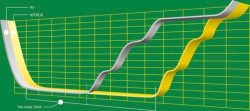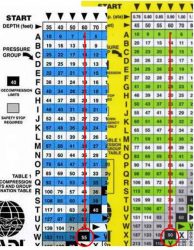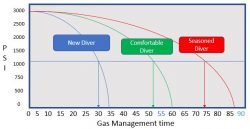Divetalking » Adv. Open Water, Article, Dive Planner, Divetalking, Education, Enriched Air, Featured, NItrox, RDP, Recreational Dive Planner, Reference, Report, Specialties, Training » Understanding Enriched Air Nitrox
Understanding Enriched Air Nitrox
September 3rd, 2020 | Comments Off on Understanding Enriched Air Nitrox
Dalton’s Law
The total pressure exerted by a mixture of gases is the sum of the pressures that would be exerted by each gas if it were alone and occupying the entire space.
Ptotal = P1 + P2 + P3 + … + Pn
We will be referencing PPO later when we dig deeper into Enriched air.
Why Use Nitrox?
Extended bottom time. When the percentage of Oxygen in a scuba cylinder is increased, the Percentage of Nitrogen is decreased.

When a scuba cylinder is filled with air, that cylinder will comprise of 21% Oxygen and 79% Nitrogen. If you are a certified diver, you should be familiar with the bottoms times allowed while diving with air. For the benefit of those who may not, diving on air to 60 feet, the No Decompression Limit is 55 minutes. Fill that same cylinder with 32% enriched air and the No Decompression Limit increases to 90 minutes. This of course is for the first dive of the day.
If understanding dive tables is something you need to learn or brush up on, this would be a good time to do so. Visit an article by clicking on Understanding the Recreational Dive Planner, RDP before continuing. Awhile later we will go over Enriched Air dive tables but only briefly since the EAN tables work the same way as the air tables.
To assist in making the purpose for dive tables a little clearer, Dive Tables calculate time. Dive tables are all about “TIME.” Time at depth, time on the surface, time between repetitive dives, No Fly Time, etc.
Question: Food for thought. Is the extended bottom time afforded by enriched air primarily due to the increase of Oxygen or the decrease of Nitrogen in the cylinder?
Answer: Due to the reduction of Nitrogen in the cylinder the allotted bottom time increases.
The table in Blue is an AIR Table. The Yellow is 32% Nitrox Table. When you compare the numbers in each of the small squares on the Nitrox table to the Air table, you will find they are greater. The Black box found at the bottom of a column (circled) is the No Decompression Limit, NDL. NDL is the maximum time for a given depth a diver may remain before they go into decompression. We want to avoid going into Decompression.

Follow the 60 foot column on both tables down to the NDL, the AIR table (in blue) shows a 55 minute MAX bottom time while the 32% Nitrox table (Yellow) shows 90 minutes MAX bottom time. That is an increase of 35 minutes of bottom time at the same depth when using Enriched Air Nitrox, EAN of 32% over that of air. That is the benefit of Nitrox, Extended bottom time.
There are other benefits and with benefits come dangers. We will cover those in more detail later. For now, let’s just stick with time as the main benefit.
When is Nitrox right for me?
There are many factors which play a roll in improving your dive time such as diving skills, buoyancy, breathing, equipment, comfort, and other factors are examples. As your experience and comfort progresses so does your gas management. You don’t run out of gas as quickly as you did when you first started.
Most when they first start diving, run out of gas in their cylinders before their bottom time runs out. As you progress in your habits, you eventually cross a line where your bottom time is now the limiting factor. When you get to a point where the majority of your dives have you returning because you are reaching the maximum bottom time, while you still have plenty of gas in your cylinder, Nitrox may be your solution.

The image above depicts three divers. The New diver consumes gas much faster and begins surfacing at around 30 minutes into a dive to 60 feet. The Comfortable divers gas management is better and begins surfacing at around 50 minutes into a dive to 60 feet where the Seasoned diver has enough gas to support the dive to 60 feet and could begin surfacing at around 75 minutes because they are diving Nitrox. The comfortable diver is a candidate for Nitrox because Nitrox will extend their bottom time.
Diver Mary, the Comfortable Diver decides to take a Nitrox course. Mary figures she is close enough to managing her gas that with more diving, she will get better and when she does, the Nitrox will be an available option to compliment that.
Does this mean you must wait for your gas management to get better before acquiring your Nitrox Certification? No, of course not. You may earn your Nitrox certification during your Open Water Training.
© 2020 – 2021, admin. All rights reserved.
Pages: 1 2 3 4 5 6 7 8 9 10 11 12 13 14 15 16
Filed under: Adv. Open Water, Article, Dive Planner, Divetalking, Education, Enriched Air, Featured, NItrox, RDP, Recreational Dive Planner, Reference, Report, Specialties, Training · Tags: diving on nitrox, EAN, Enriched air, enriched air nitrox, learn about nitrox, Nitrox, Nitrox certification, Understanding nitrox, Viewport, what is enriched air, What is nitrox
Scuba Diving Calculators
** This will affect all calculations
Cloud Tag
Most commented
Recent Articles
- Where is the Hyperbaric Chamber?
- Clicky.com Advanced real-time web analytics
- Divers and crew missing after Red Sea liveaboard Sea Story sinks
- Nekton’s Rorqual and Pilot, former scuba lieaboards to become artificial reefs off Destin-Fort Walton Beach
- Laser Engraving, Marking and Cleaning of High-Pressure Vessels
- Loggerhead Holdings, Inc Joint Law Suit
Tag Cloud
artificial reef blowing up reefs Canon 5D Mark III cay sal conservation cozumel death dive diver dive show divetalking dolphin explosive reefs FIsh ID fishinar Fred Morrow Fred Morrow Artificial Reef Fred Morrow Reef FWC Leatherback lionfish lion fish lionfish derby lionfish harvesting logo lost missing Narcosis Nekton Ocean Photography polution Preservation RDP recall Recreational Dive Planner reef scuba show Sharks Shark Weak titanic tuna Underwater Photography Workshop Zeagle© 2026 Divetalking








